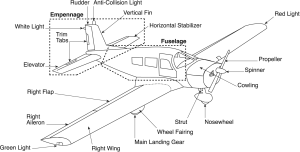Experienced pilots know their aircraft inside and out, knowing the function of even very minor parts. Here are some of the most important parts of an airplane as described by Bob Gardner in The Complete Private Pilot:
Fuselage
The fuselage (or cabin, in most modern airplanes) is the basic structure to which the wings and empennage are attached. Most of the small airplanes you will see during your flight training are unpressurized–you can tell by the square windows and non-airtight doors. Airplanes that are pressurized for passenger comfort at high altitudes have round or oval windows and tight-fitting doors.
The fuselage of almost every airplane you see will be of aluminum construction with internal strengthening members. A close look will show that on some models, more attention has been paid to reducing drag caused by rivet heads and other protrusions. Looking at non-metal airplanes will take you to both the past and and the future. Fabric-covered airplanes with tubing structures (wood-framed airplanes are really classics!) are lovingly restored and flown proud by owners. No less proud are the pilots of modern composite aircraft, formed with plastic reinforced with glass fibers, carbon fibers, or similar materials which offer great strength and minimal drag. Most light sport aircraft (LSA) and technically advanced aircraft (TAA) are made of composites.
It is altogether possible that you might take your initial training in a composite airplane, but right now they are outnumbered by aluminum planes.
Wings
The “main spar” within the wing is the structural member that supports the load. Airfoil-shaped ribs are attached to the main spar and the metal or fabric skin is attached to the ribs to give the wing its shape, and it is that airfoil shape that makes the wing capable of developing enough lift to support the airplane in flight. The wings of composite aircraft are formed with molds that have no internal ribs. They do have a main spar, of course.
Almost all modern airplanes have a single wing, mounted either above or below the fuselage. Most, but not all, high wing airplanes have supporting struts. Low wing and strutless high wing airplanes are cantilevered: the internal structure is designed to support the load so there are no struts.
Empennage
The horizontal stabilizer, the rudder, the vertical fin, the elevator, or any combination thereof is called the airplane’s empennage, or “tail feathers.” These surfaces allow the pilot to change the airplane’s attitude in relation to the horizon by moving the nose up and down (using he yoke or control stick) or left and right (using the rudder pedals) as seen by the pilot. There may be a fixed horizontal stabilizer with a movable elevator, or the whole horizontal assembly may be moveable (called a stabilator).
You can purchase The Complete Private Pilot on our website at ASA2Fly.com, which also contains even more resources for student pilots. We will continue this series on Thursday.





